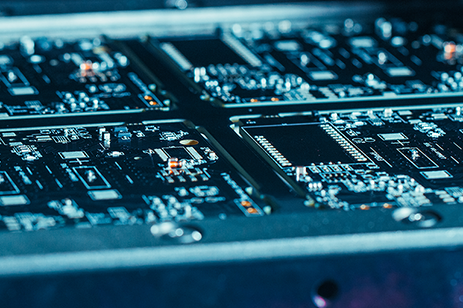
Curtiss-Wright’s CHAMP-XDx DSP module family, including the industry’s only dual-Intel Xeon-D 6U OpenVPX board, is now qualified to -40° to 85°C operating temperature range and extreme shock/vibration levels
ASHBURN, VA. – May 25, 2017 -- Curtiss-Wright’s Defense Solutions division today announced that it is the embedded industry’s first COTS supplier to successfully qualify its full range of supercomputer-class Intel® Xeon®-D based conduction-cooled 3U and 6U OpenVPX DSP modules to the -40°C to 85°C operating temperature range. This notable achievement ensures that Curtiss-Wright’s family of CHAMP-XDx DSP modules is able to deliver unmatched performance in extremely harsh deployed defense and aerospace environments, including an unprecedented ability to mitigate processor “throttling” across the -40°C to 85°C (Level 200) operating temperature range. The boards were also successfully qualified to perform optimally in the intense shock and vibration conditions encountered by the most demanding defense and aerospace platforms, such as the extreme forces resulting from the maneuvers and acceleration typical of fighter jets. These types of platforms operate at high speeds in high-altitude environments where a lack of atmosphere eliminates the ability to cool with forced air techniques, making conduction cooling essential.
Now qualified for operation over the full military temperature range, the rugged conduction-cooled CHAMP-XDx modules have earned Curtiss-Wright’s Level 200 (L200) designation, one of the industry’s highest ruggedization levels. With its L200 rating, the 6U CHAMP-XD2, already the industry’s only dual Xeon-D DSP module now delivers the highest performance and highest level of conduction cooling available for a COTS DSP module. With their ability to operate optimally with the extreme heat of an 85°C card edge, Curtiss-Wright’s CHAMP-XDx modules are the industry’s first DSP modules able to mitigate the risk of the performance degrading throttling typically experienced by lower-rated conduction-cooled modules when operated at the extreme limits of the processor’s operating temperature range. The L200 CHAMP-XDx modules’ ability to mitigate throttling is especially important for demanding applications, such as airborne active electronically scanned array (AESA) Radar, for which deterministic timing is critical.
“We are extremely proud to announce that our industry-leading conduction-cooled Xeon-D-based DSP modules are now qualified for operation in the extremely harsh -40°C to 85°C temperature range to support the most demanding deployed ISR applications,” said Lynn Bamford, Senior Vice President, and General Manager, Defense Solutions division. “This level of ruggedization is one of the hardest objectives to achieve for a conduction-cooled COTS module design, and enables the DSP processor to operate at higher temperatures without performance throttling, which can, for example, reduce the operational effectiveness of an aircraft’s AESA radar, especially when the pilot needs it most.”
About Level 200 Ruggedization
Curtiss-Wright’s L200 manufacturing and qualification process is one of the most extreme in the industry. It is designed to ensure that conduction-cooled COTS modules can survive the extreme environmental conditions that warfighters and their platforms must endure. L200 performance specifications include:
- Operating Temp.: -40°C to 85°C
- Non-operating Temp.: -55°C to 125°C
- Operating Humidity: 0-100% non-condensing
- Non-operating Humidity (Storage): 0-100% condensing
- Vibration Sine:
- 10 g peak 5-2,000 Hz
- Vibration Random:
- 0.005 @ 5 Hz
- @ 15 Hz
- @ 2,000 Hz
- 0.005 @ 5 Hz
- Shock: 40 g peak
- Altitude: -1,500 to 60,000 ft
- Conformal Coat
Mitigating Throttling
When some processor modules aren’t cooled to proper temperatures their on-board processor(s) can reach a specific internal temperature that initiates a “throttle-back” condition, reducing the device’s performance in order to protect against over-heating. This type of temperature-induced throttling can result in the uncontrolled degradation of the processor clock and is highly undesirable for compute-intensive applications such as AESA Radar that depend on maximum computation and real-time deterministic timing performance. The L200-rated CHAMP-XDx modules are able to keep their Intel Xeon-D processors cool at extreme levels of performance, effectively mitigating the risk of throttling. Curtiss-Wright’s intensive qualification and testing process results in detailed information, including full characterization of the modules’ throttling mitigating performance, and can be provided to system integrators. This data enables integrators to fully understand how CHAMP-XDx modules significantly reduce the risk of throttling at 85°C operating temperatures in comparison to competing designs that can only be qualified for operation at 71°C.
The Conduction Cooling Experts: Advanced Thermal Management Equals Reliability
With a heritage of more than 30 years, Curtiss-Wright has long been recognized as the COTS industry’s leading expert in the design of conduction-cooled standards-based modules. The CHAMP-XDx family of modules features some of the most sophisticated thermal frames yet developed by the Company, leveraging next-generation thermal interface materials and advanced heat pipe technology that enables great amounts of heat to be rapidly dissipated. Their groundbreaking design results from research and investment in the latest thermal dissipation technologies.
The ability to successfully cool the Xeon-D processors and other components on the CHAMP-XDx modules delivers far greater reliability, extending product MTBF, so that platform mission hours are maximized. Modules qualified to the wider operating temperature ranges will have fewer failures in the harsh tactical fighter environment, for example, than those qualified to less stringent requirements. What’s more, the platform operator will spend less on spares and repairs due to fewer failures. The result of advanced conduction cooling is more reliable hardware with higher levels of operational readiness and full operational capability.
About Curtiss-Wright Corporation
Curtiss-Wright Corporation is a global innovative company that delivers highly engineered, critical function products and services to the commercial, industrial, defense and energy markets. Building on the heritage of Glenn Curtiss and the Wright brothers, Curtiss-Wright has a long tradition of providing reliable solutions through trusted customer relationships. The company employs approximately 8,000 people worldwide. For more information, visit www.curtisswright.com.
###
NOTE: All trademarks are property of their respective owners.